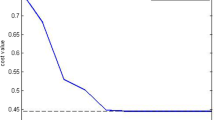Abstract
A minimisation problem with infinitely many constraints – semi-infinite programming problem (SIP) is considered. The problem is solved using a two stage procedure that searches for global maximum violation of the constraints. A version of the algorithm that searches for any violation of constraints is also considered, and the performance of the two algorithm is compared. An application to solving minimax problem (with and without coupled constraints) is given and a comparison with the algorithm for continuous minimax of Rustem and Howe (2001) is included. Finally, we consider an application to chemical engineering problems.
Similar content being viewed by others
References
Asprey, S.P. and S. Macchietto. (2000). “Statistical Tools for Optimal Dynamic Model Building.” Comput. Chem. Eng. 24, 1261–1267.
Blankenship, J.W. and J.E. Falk. (1976). “Infinitely Constrained Optimization Problems.” JOTA 19, 261–281.
Boyd, S., L. El Ghaoui, E. Feron, and V. Balakrishnan. (1994). Linear Matrix Inequalities in Systems and Control Theory. Philadelphia, PA: SIAM.
Coope, I.D. and G.A. Watson. (1985). “A Projected Lagrangian Algorithm for Semi-Infinite Programming.” Math. Programming 32, 337–356.
Danskin, J.M. (1967). The Theory of Max-Min. Berlin: Springer.
Darlington, J., C.C. Pantelides, B. Rustem, and B.A. Tanyi. (1999). “An Algorithm for Constrained Nonlinear Optimization under Uncertainty.” Automatica 35, 217–228.
Demyanov, V.F. and A.B. Pevnyi. (1971). “Numerical Methods for Finding Saddle Points.” USSR Comput. Math. and Math. Phys. 12, 1099–1127.
Grossmann, I.E. and R.W.H. Sargent. (1978). “Optimum Design of Chemical Plants with Uncertain Parameters.” AIChE J. 24, 1021–1028.
Gustafson, S.A. (1981). “A Three-Phase Algorithm for Semi-Infinite Programming.” In A.V. Fiacco and O. Kortanek (eds.), Semi-Infinite Programming and Applications. Lecture Notes in Economics and Mathematical Systems, Vol. 215, Berlin: Springer, pp. 138–157.
Halemane, K.P. and I.E. Grossmann. (1983). “Optimal Process Design Under Uncertainty.” AIChE J. 29, 425–433.
Hettich, R. and K.O. Kortanek. (1993). “Semi-Infinite Programming: Theory, Methods and Applications.” SIAM Review 35, 380–429.
John, F. (1948). “Extremum Problems with Inequalities as Subsidiary Condition.” In Studies and Essays, Courant Anniversary Volume. New York: Wiley.
Kall, P. and S. Wallace. (1994). Stochastic Programming. New York: Wiley.
Kwak, B.M. and E.J. Haug. (1976). “Optimum Design in the Presence of Parametric Uncertainty.” JOTA 19, 527–546.
Mayne, D.Q., E. Polak, and R. Trahan. (1979). “An Outer Approximation Algorithm for Computer-Aided Design Problems.” JOTA 28, 331–352.
Monahan, G.E. (1996). “Finding Saddle Points on Polyhedra: Solving Certain Continuous Minimax Problems.” Naval Research Logistics 43, 821–837.
NAG Library. “Subroutine E04UCF.” Available at WWW: http://www.nag.co.uk/numeric/fl/manual/html/ FLlibrarymanual.asp
Panin, V.M. (1981). “Linearization Method for Continuous Min-Max Problems.” Kibernetika 2, 75–78.
Polak, E. and D.Q. Mayne. (1976). “An Algorithm for Optimization Problems with Functional Inequality Constraints.” IEEE Transactions on Automatic Control 21, 184–193.
Prekopa, A. (1995). Stochastic Programming. Budapest: Akademiai Kiado.
Rinnooy Kan, A. and G.T. Timmer. (1987). “Stochastic Global Optimization Methods. Part II: Multilevel Methods.” Mathematical Programming 78, 39–57.
Rockafeller, R.T. (1972). Convex Analysis. Princeton, NJ: Princeton University Press.
Rosen, J.B. (1965). “Existence and Uniqueness of Equilibrium Points for Concave n-Person Games.” Econometrica 33, 520–534.
Rustem, B. and M.A. Howe. (2001). Algorithms for Worst-Case Design and Applications to Risk Management. Princeton, NJ: Princeton University Press.
Zakovic, S., C.C. Pantelides, and B. Rustem. (2000). “An Interior Point Algorithm for Computing Saddle Points of Constrained Continuous Minimax.” Annals of Operations Research 99, 59–77.
Sasai, H. (1974). “An Interior Penalty Method for Minimax Problems with Constraints.” SIAM J. Control 12, 643–649.
Shimizu, K. and E. Aiyoshi. (1980). “Necessary Conditions for Min-Max Problems and Algorithms by a Relaxation Procedure.” IEEE Transactions on Automatic Control 25, 62–66.
Vandenberghe, L. and S. Boyd. (1998). “Connections between Semi-Infinite and Semidefinite Programming.” In R. Reemtsen and J.J. Rueckmann (eds.), Semi-Infinite Programming. Dordrecht: Kluwer Academic, pp. 277–294.
Author information
Authors and Affiliations
Corresponding author
Rights and permissions
About this article
Cite this article
Žaković, S., Rustem, B. Semi-Infinite Programming and Applications to Minimax Problems. Annals of Operations Research 124, 81–110 (2003). https://doi.org/10.1023/B:ANOR.0000004764.76984.30
Issue Date:
DOI: https://doi.org/10.1023/B:ANOR.0000004764.76984.30




